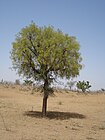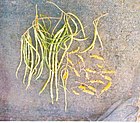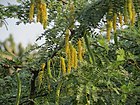Note: This is a project under development. The articles on this wiki are just being initiated and broadly incomplete. You can Help creating new pages.
Prosopis cineraria - Indian mesquite
Prosopis cineraria is a moderate sized throny tree with bipinnate leaves distributed from Iran to India. Within India, it is found in the dry and arid regions on the alluvial plains.
Contents
- 1 Uses
- 2 Parts Used
- 3 Chemical Composition
- 4 Common names
- 5 Properties
- 6 Habit
- 7 Identification
- 8 List of Ayurvedic medicine in which the herb is used
- 9 Where to get the saplings
- 10 Mode of Propagation
- 11 How to plant/cultivate
- 12 Commonly seen growing in areas
- 13 Photo Gallery
- 14 References
- 15 External Links
Uses
Skin diseases, Cysts, Tumours, Cough, Bronchitis, Asthma, Piles, Dysentery, Diarrhea.[1]
Parts Used
Chemical Composition
Common names
| Language | Common name |
|---|---|
| Kannada | Banni mara, Perumbe |
| Hindi | Khejri, Sami |
| Malayalam | Paramba |
| Tamil | Parambai, Vanni |
| Telugu | Jammi, Priyadarshini |
| Marathi | NA |
| Gujarathi | NA |
| Punjabi | NA |
| Kashmiri | NA |
| Sanskrit | Shami |
| English | Shami tree |
Properties
Reference: Dravya - Substance, Rasa - Taste, Guna - Qualities, Veerya - Potency, Vipaka - Post-digesion effect, Karma - Pharmacological activity, Prabhava - Therepeutics.
Dravya
Rasa
Kashaya (AStringent), Madhura (Sweet)
Guna
Laghu (Light), Rooksha (Dry)
Veerya
Sheeta (cold)
Vipaka
Katu (Pungent)
Karma
Pitta, Kapha
Prabhava
Habit
Identification
Leaf
| Kind | Shape | Feature |
|---|---|---|
| Bipinnate | Alternate | Leaves 1-3-jugate, glabrous or puberulous; petiole and rachis 0.5-4 cm long, the pinnae 2-7 cm long; leaflets 7-14-jugate, ovate, straight to subfalcate. |
Flower
| Type | Size | Color and composition | Stamen | More information |
|---|---|---|---|---|
| Bisexual | Spiciform racemes | Pale yellow | 5-13 cm long, several together, subpaniculate; peduncle with amplexicaul bract (or 2 bracts united), this caducous and leaving an oblique scar, 1.5-2 mm long; bractlets ovate, sessile, 0.5-0.8 mm long. |
Fruit
| Type | Size | Mass | Appearance | Seeds | More information |
|---|---|---|---|---|---|
| A Pod | 8 - 9 cm long | Fruit slender, elongate, 8-19 cm long (including the stipe 0.8-2 cm), subcylindric-torulose, 4-7 mm in diameter, glabrous; pericarp thin, brittle. | {{{5}}} | {{{6}}} |
Other features
List of Ayurvedic medicine in which the herb is used
Where to get the saplings
Mode of Propagation
How to plant/cultivate
Propagation material is seeds collected during May-June from plus trees.[4]
Commonly seen growing in areas
Photo Gallery
References
- ↑ Uses
- ↑ Vernacular names
- ↑ Kappatagudda - A Repertoire of Medicianal Plants of Gadag by Yashpal Kshirasagar and Sonal Vrishni, Page No. 318
- ↑ Cultivation details
External Links
- Ayurvedic Herbs known to be helpful to treat Skin diseases
- Ayurvedic Herbs known to be helpful to treat Cysts
- Ayurvedic Herbs known to be helpful to treat Tumours
- Ayurvedic Herbs known to be helpful to treat Cough
- Ayurvedic Herbs known to be helpful to treat Bronchitis
- Ayurvedic Herbs known to be helpful to treat Asthma
- Ayurvedic Herbs known to be helpful to treat Piles
- Ayurvedic Herbs known to be helpful to treat Dysentery
- Ayurvedic Herbs known to be helpful to treat Diarrhea
- Herbs with Bark used in medicine
- Herbs with Fruits used in medicine
- Herbs with common name in Kannada
- Herbs with common name in Hindi
- Herbs with common name in Malayalam
- Herbs with common name in Tamil
- Herbs with common name in Telugu
- Herbs with common name in Sanskrit
- Herbs with common name in English
- Habit - Tree
- Index of Plants which can be propagated by Seeds
- Index of Plants which can be propagated by Cuttings
- Herbs that are commonly seen in the region of Tropical area
- Herbs
- Fabaceae
- Ayurvedic herbs that don't have seed photos






